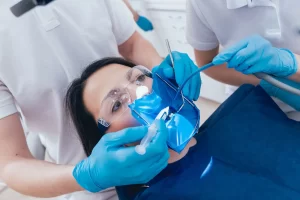How Tooth Extraction Works
The tooth extraction process is a routine procedure in which a dentist or oral surgeon removes a tooth from a patient’s mouth. There are two variations of the tooth extraction process — simple and surgical tooth extractions. Dentists take many precautions to protect the patient’s gums and bone structures surrounding the extracted tooth.
Read the following guide to the tooth extraction process to understand what to expect during your procedure. Call (413) 538-7400 to learn more from our dentist in Holyoke, MA.
Why Dentists Recommend Tooth Extraction
When a patient visits the dentist for a tooth removal, the dentist will carefully evaluate the situation and discuss all available options before deciding whether extraction is the best method for the patient’s oral health. Ultimately, the decision to extract a tooth is made on a case-by-case basis, considering the patient’s overall oral health condition and the specific circumstances surrounding the affected tooth.
A dentist may decide to extract a tooth for various reasons, including:
- Tooth decay: When a tooth is extensively decayed, it may not be possible to save it with a filling, crown, or other restoration.
- Periodontal disease: If a tooth has been severely affected by gum disease, it may become loose and need an extraction.
- Overcrowding: If a patient’s mouth is overcrowded and there’s not enough room for all the teeth, the dentist may recommend extracting one or more teeth to create space.
- Impacted teeth: Sometimes teeth become impacted, meaning they’re trapped beneath the gum line and cannot erupt properly. In these cases, extraction may be necessary to prevent further dental complications from developing.
- Orthodontic treatment: When a patient undergoes orthodontic treatment, sometimes teeth need to be extracted to make room for proper alignment of the remaining teeth.
The Tooth Extraction Process
The tooth extraction process involves several steps and may vary slightly depending on the specific situation, the type of extraction, and the dentist’s approach. You can expect to encounter the following:
- Evaluation: Before the extraction, the dentist will evaluate the tooth and surrounding area, taking X-rays if necessary, to determine the best approach and identify any potential complications.
- Anesthetic: The dentist will administer local anesthesia to numb the area around the tooth. In some cases, dentists employ dental sedation.
- Loosening the tooth: Using specialized tools, the dentist will gently loosen the tooth from the surrounding gum and bone tissue.
- Extraction: Once the tooth is sufficiently loose, the dentist will use forceps to carefully rock it back and forth, removing it from the tooth socket. The tooth may need to be sectioned or cut into pieces to make removal easier.
- Cleaning and suturing: After the tooth extraction, the dentist will clean the area and may place stitches to help the tissue heal properly. A small piece of gauze or other material may be placed over the extraction site to help stop bleeding.
- Post-operative care: The dentist will provide instructions on how to care for the extraction site and manage any discomfort or swelling. These directions may include taking pain medication, avoiding certain foods and activities, and using ice or heat therapy.
Following the dentist’s instructions carefully after a tooth extraction is crucial to minimizing the risk of complications and promoting proper healing. With gentle care, most people fully recover within a few days to a week after tooth extraction.
The Simple and Surgical Extraction Processes
A simple tooth extraction is performed on a tooth visible in the mouth and not impacted, meaning it’s not hidden beneath the gum line. This procedure involves numbing the area around the tooth with a local anesthetic, loosening it with specialized tools, and gently removing it from the socket. A simple extraction can usually be completed in a single visit and doesn’t require incisions or sutures.
In contrast, surgical tooth extraction is a more complex procedure performed on impacted, broken, or difficult-to-access teeth. This type of extraction may also be necessary if the tooth has multiple roots or is close to sensitive structures such as nerves or sinuses.
During a surgical extraction, the dentist or oral surgeon may need to make a small incision in the gum tissue to access the tooth and remove some bone tissue to extract it. This procedure may require dental sedation or general anesthesia, and it may require several visits to complete. Following a surgical extraction, the patient may need to follow more detailed aftercare instructions to promote proper healing.
Frequently Asked Questions
Tooth extraction is safe, but like any medical procedure, it does carry some risks. These risks may include bleeding, infection, damage to surrounding teeth or structures, and dry socket, a painful condition that can occur when the blood clot in the extraction site becomes dislodged. The dentist will discuss potential risks or complications with the patient before the procedure.
Most tooth extractions require a local anesthetic to numb the area around the tooth. In some cases, the dentist or oral surgeon may recommend sedation or general anesthesia to ensure the patient’s comfort and safety during the procedure.
If the patient receives only a local anesthetic, they should be able to drive home after the procedure. However, if the patient receives sedation or general anesthesia, they’ll need someone to drive them home and stay with them for a while until the effects of the anesthesia wear off.
The length of a tooth extraction procedure can vary depending on the complexity of the extraction and the individual patient’s situation. A simple extraction may take only a few minutes, while a surgical extraction may take up to an hour or more.
Learn More About the Tooth Extraction Process
Tooth extraction is a common dental procedure that may be necessary for several reasons, including decay, infection, trauma, or overcrowding. While the thought of having a tooth extracted may be intimidating to some patients, remember that modern techniques and anesthesia can minimize discomfort and ensure a safe and successful procedure.
Learn more about the dental extraction process by contacting your dentist at Holyoke. We serve patients in the Greater Springfield area, including Westfield, Southampton, South Hadley, and nearby Western Massachusetts communities.

